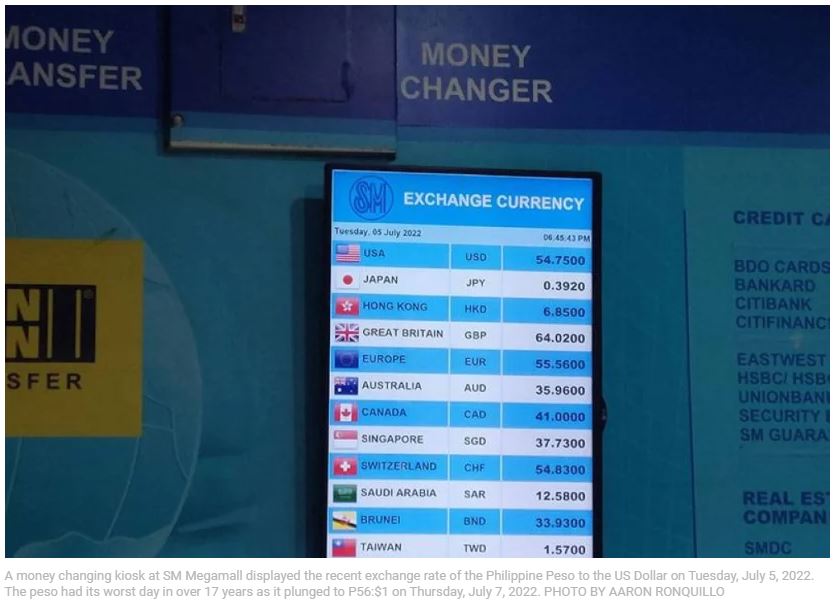Philippines: Peso falls to nearly 17-year low
THE Philippine peso had its worst day in over 17 years, falling to P56 to the US dollar on Thursday.
The local currency decreased 39 centavos from the P55.67 closing value of the previous day to end at $56.06:$1. It hasn’t been this soft since Sept. 27, 2005 when it closed at 56.29:$1.
Nicholas Antonio Mapa, senior economist at ING Bank Manila, observed that this week’s trade has been dominated by wide US dollar strength as investors sought safe haven due to recessionary fears.
The dollar also strengthened because it appears that the US Federal Reserve (Fed) would tighten policy in order to stop US inflation.
“The PHP (peso) has moved alongside regional currencies, weakening against the USD (dollar) due to these factors,” he explained.
For his part, Robert Dan Roces, an economist and assistant vice president of Security Bank Corp., linked the peso’s depreciation to risk aversion with concerns about global growth remaining at the forefront.
He added, “Today’s levels followed stronger-than-expected data from the US as well as more hawkish indications from the Fed as seen in the FOMC (Federal Open Market Committee) minutes released this morning.”
The US Federal Reserve’s open market operations are overseen by the FOMC.
In the meantime, Michael Ricafort, chief economist at Rizal Commercial Banking Corp., said the “peso is also weaker after softer unemployment and manufacturing data that could already reflect the effects of higher prices/inflation and higher long-term interest rates/borrowing costs that may be a drag on economic recovery prospects.”
According to a report released by the Philippine Statistics Authority on Thursday, the country’s unemployment rate increased to 6 percent in May 2022 from 5.7 percent in April this year by 0.3 percentage point. As a result, the number of jobless persons picked up to 2.93 million in May from 2.76 million in April.
On the other hand, compared to a year ago, the manufacturing sector’s growth decreased in May 2022. The rise in the volume of production index slowed to 1.9 percent from 267.2 percent a year earlier, while the growth in the value of production index eased to 7.6 percent from 256.1 percent in May 2021.
Domini Velasquez, senior economist at China Banking Corp., projected that the peso will continue to trend lower through the third quarter as a result of the Federal Reserve’s aggressive rate hikes and a growing trade deficit.
She added that the peso rate will act as an instrument for rebalancing the economy as long as it is determined by market fundamentals.
“However, there are some concerns, such as its impact on inflation, which the BSP is monitoring. Moreover, the recent pace of the depreciation, starting June may also be concerning, especially if it fuels speculative behavior,” Velasquez warned.
Source: https://www.manilatimes.net/2022/07/08/business/top-business/peso-falls-to-nearly-17-year-low/1850175


 English
English




